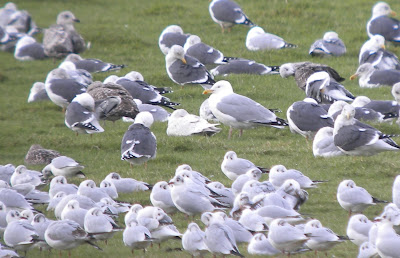The day started off at Westport as per usual, but even with the presence of PJ, it wasn't very productive, and the quiet start to the year continued at the Golden Pond.
Then, I thought I had better pop into Fenton Park to see the LESSER WHITETHROAT again, having not year ticked it yet. Mr Birding Frontier aka Martin Garner had been down to see it recently and had written an interesting article on it, suggesting it was indeed an EASTERN LESSER WHITETHROAT. We walked down to the sunken garden and stood and waited. I started to wonder how long would it be for it to appear and how long were we prepared to wait for it, when, as if by magic, it appeared it the trees above us. Lesser Whitethroat -A January tick and all done and dusted in two minutes. Talk about tick and run!
Next target bird was the female RED-CRESTED POCHARD at Copmere. This wasn't so easy, mainly due to the fact that viewing the lake is a nightmare. There is just no clear view - its always through the trees. Even Roy Wents watchpoint is obscured by trees. We eventually went down to the bottom where the fishermen go in and eventually found the Red-crested Pochard. Excuse the photo, I had a tree blocking my view.

Red-crested Pochard at Copmere (or Cockmere as it was put out on Birdnet)
We were on a roll now, but we felt the next target wouldn't be as easy. We headed to Belvide for the 1w drake Scaup. Now this bird could have been anywhere but luckily, I found it from the first hide, showing distantly in the corner. No photo's of this I'm afraid.
Off to the Pits next, and some proper birding for a change. We popped into Whitemoor Haye on the way, seeing two Grey Partridges, the two Little Owls showed a treat and we also added Tree Sparrow and Yellowhammer to our Whitemoor day list.


Little Owls at Whitemoor Haye
Branston GP's was not bad despite quite a bit of shooting going on in the area. We faced the task of getting through Dead Mans Wood mid Pheasant shoot, but fortunately it stopped just as we approached, and we had a nice chat with the gamekeeper. He had no complaints it was good to hear. We also didn't end up in the pot, which was also quite good. We had 97 Golden Plovers, a Green Sandpiper, three Ruff, two Redshank and a Kingfisher.



Two of the three Ruff, two Redshank and a Curlew at Branston
We finished off the day very nicely by watching a drake Smew and two Egyptian Geese, plus a sign of spring with my first Staffordshire Oystercatcher of the year. A fine day where everything fell into place so nicely.

Drake Smew

First Oystercatcher back in Staffordshire

Heron in the late afternoon sun

Record shot of two Egyptian Geese - magical birds!















































